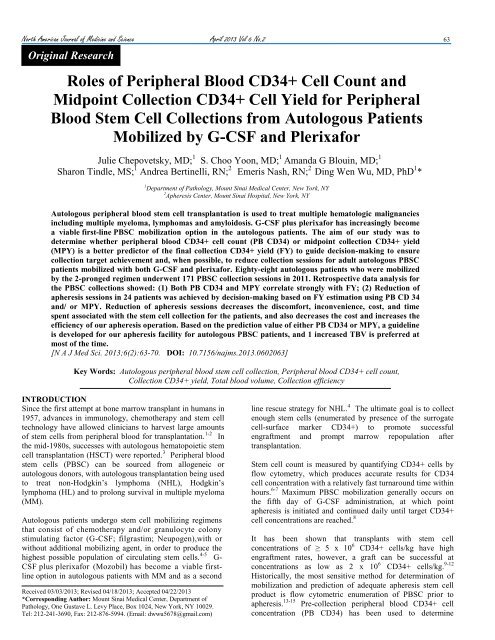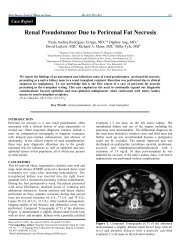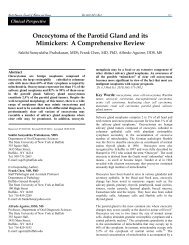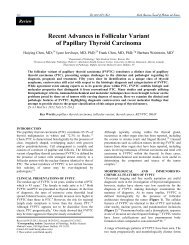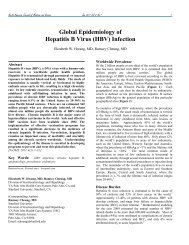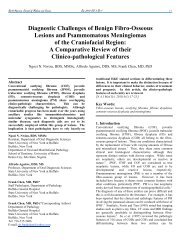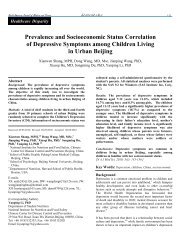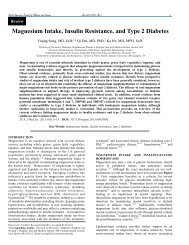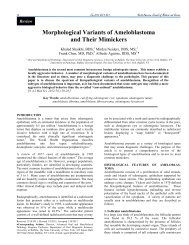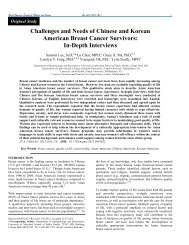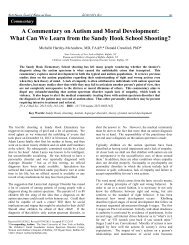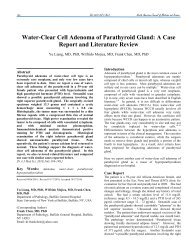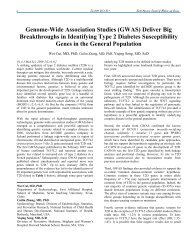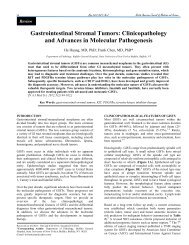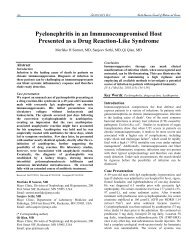Roles of Peripheral Blood CD34+ Cell Count and Midpoint ...
Roles of Peripheral Blood CD34+ Cell Count and Midpoint ...
Roles of Peripheral Blood CD34+ Cell Count and Midpoint ...
Create successful ePaper yourself
Turn your PDF publications into a flip-book with our unique Google optimized e-Paper software.
North American Journal <strong>of</strong> Medicine <strong>and</strong> Science April 2013 Vol 6 No.2 63<br />
Original Research<br />
<strong>Roles</strong> <strong>of</strong> <strong>Peripheral</strong> <strong>Blood</strong> <strong>CD34+</strong> <strong>Cell</strong> <strong>Count</strong> <strong>and</strong><br />
<strong>Midpoint</strong> Collection <strong>CD34+</strong> <strong>Cell</strong> Yield for <strong>Peripheral</strong><br />
<strong>Blood</strong> Stem <strong>Cell</strong> Collections from Autologous Patients<br />
Mobilized by G-CSF <strong>and</strong> Plerixafor<br />
Julie Chepovetsky, MD; 1 S. Choo Yoon, MD; 1 Am<strong>and</strong>a G Blouin, MD; 1<br />
Sharon Tindle, MS; 1 Andrea Bertinelli, RN; 2 Emeris Nash, RN; 2 Ding Wen Wu, MD, PhD 1 *<br />
1 Department <strong>of</strong> Pathology, Mount Sinai Medical Center, New York, NY<br />
2 Apheresis Center, Mount Sinai Hospital, New York, NY<br />
Autologous peripheral blood stem cell transplantation is used to treat multiple hematologic malignancies<br />
including multiple myeloma, lymphomas <strong>and</strong> amyloidosis. G-CSF plus plerixafor has increasingly become<br />
a viable first-line PBSC mobilization option in the autologous patients. The aim <strong>of</strong> our study was to<br />
determine whether peripheral blood <strong>CD34+</strong> cell count (PB CD34) or midpoint collection <strong>CD34+</strong> yield<br />
(MPY) is a better predictor <strong>of</strong> the final collection <strong>CD34+</strong> yield (FY) to guide decision-making to ensure<br />
collection target achievement <strong>and</strong>, when possible, to reduce collection sessions for adult autologous PBSC<br />
patients mobilized with both G-CSF <strong>and</strong> plerixafor. Eighty-eight autologous patients who were mobilized<br />
by the 2-pronged regimen underwent 171 PBSC collection sessions in 2011. Retrospective data analysis for<br />
the PBSC collections showed: (1) Both PB CD34 <strong>and</strong> MPY correlate strongly with FY; (2) Reduction <strong>of</strong><br />
apheresis sessions in 24 patients was achieved by decision-making based on FY estimation using PB CD 34<br />
<strong>and</strong>/ or MPY. Reduction <strong>of</strong> apheresis sessions decreases the discomfort, inconvenience, cost, <strong>and</strong> time<br />
spent associated with the stem cell collection for the patients, <strong>and</strong> also decreases the cost <strong>and</strong> increases the<br />
efficiency <strong>of</strong> our apheresis operation. Based on the prediction value <strong>of</strong> either PB CD34 or MPY, a guideline<br />
is developed for our apheresis facility for autologous PBSC patients, <strong>and</strong> 1 increased TBV is preferred at<br />
most <strong>of</strong> the time.<br />
[N A J Med Sci. 2013;6(2):63-70. DOI: 10.7156/najms.2013.0602063]<br />
Key Words: Autologous peripheral blood stem cell collection, <strong>Peripheral</strong> blood <strong>CD34+</strong> cell count,<br />
Collection <strong>CD34+</strong> yield, Total blood volume, Collection efficiency<br />
INTRODUCTION<br />
Since the first attempt at bone marrow transplant in humans in<br />
1957, advances in immunology, chemotherapy <strong>and</strong> stem cell<br />
technology have allowed clinicians to harvest large amounts<br />
<strong>of</strong> stem cells from peripheral blood for transplantation. 1-2 In<br />
the mid-1980s, successes with autologous hematopoietic stem<br />
cell transplantation (HSCT) were reported. 3 <strong>Peripheral</strong> blood<br />
stem cells (PBSC) can be sourced from allogeneic or<br />
autologous donors, with autologous transplantation being used<br />
to treat non-Hodgkin’s lymphoma (NHL), Hodgkin’s<br />
lymphoma (HL) <strong>and</strong> to prolong survival in multiple myeloma<br />
(MM).<br />
Autologous patients undergo stem cell mobilizing regimens<br />
that consist <strong>of</strong> chemotherapy <strong>and</strong>/or granulocyte colony<br />
stimulating factor (G-CSF; filgrastim; Neupogen),with or<br />
without additional mobilizing agent, in order to produce the<br />
highest possible population <strong>of</strong> circulating stem cells. 4-5 G-<br />
CSF plus plerixafor (Mozobil) has become a viable firstline<br />
option in autologous patients with MM <strong>and</strong> as a second<br />
Received 03/03/2013; Revised 04/18/2013; Accepted 04/22/2013<br />
*Corresponding Author: Mount Sinai Medical Center, Department <strong>of</strong><br />
Pathology, One Gustave L. Levy Place, Box 1024, New York, NY 10029.<br />
Tel: 212-241-3690, Fax: 212-876-5994. (Email: dwwu5678@gmail.com)<br />
line rescue strategy for NHL. 4 The ultimate goal is to collect<br />
enough stem cells (enumerated by presence <strong>of</strong> the surrogate<br />
cell-surface marker <strong>CD34+</strong>) to promote successful<br />
engraftment <strong>and</strong> prompt marrow repopulation after<br />
transplantation.<br />
Stem cell count is measured by quantifying <strong>CD34+</strong> cells by<br />
flow cytometry, which produces accurate results for CD34<br />
cell concentration with a relatively fast turnaround time within<br />
hours. 6-7 Maximum PBSC mobilization generally occurs on<br />
the fifth day <strong>of</strong> G-CSF administration, at which point<br />
apheresis is initiated <strong>and</strong> continued daily until target <strong>CD34+</strong><br />
cell concentrations are reached. 8<br />
It has been shown that transplants with stem cell<br />
concentrations <strong>of</strong> ≥ 5 x 10 6 <strong>CD34+</strong> cells/kg have high<br />
engraftment rates, however, a graft can be successful at<br />
concentrations as low as 2 x 10 6 <strong>CD34+</strong> cells/kg. 9-12<br />
Historically, the most sensitive method for determination <strong>of</strong><br />
mobilization <strong>and</strong> prediction <strong>of</strong> adequate apheresis stem cell<br />
product is flow cytometric enumeration <strong>of</strong> PBSC prior to<br />
apheresis. 13-15 Pre-collection peripheral blood <strong>CD34+</strong> cell<br />
concentration (PB CD34) has been used to determine
64 April 2013 Vol 6 No.2 North American Journal <strong>of</strong> Medicine <strong>and</strong> Science<br />
necessity <strong>of</strong> the apheresis procedure, processing volume <strong>and</strong><br />
number <strong>of</strong> procedure days. 16-19 Other studies have evaluated<br />
the predictive potential <strong>of</strong> intra-procedural enumeration <strong>of</strong><br />
<strong>CD34+</strong> cell concentration on final stem cell yield (FY) in the<br />
setting <strong>of</strong> fixed-volume apheresis <strong>and</strong> in the pediatric<br />
population. 20-22 To our knowledge, predictive values <strong>of</strong> both<br />
PB CD34 <strong>and</strong> midpoint collection <strong>CD34+</strong> yield (MPY) have<br />
not been reported for patients mobilized with both G-CSF <strong>and</strong><br />
plerixafor.<br />
Here we report our findings for predictive values <strong>of</strong> both PB<br />
CD34 <strong>and</strong> MPY on FY for adult autologous PBSC patients<br />
mobilized with G-CSF <strong>and</strong> plerixafor.<br />
METHODS<br />
At our institution, the minimum <strong>and</strong> optimal stem cell<br />
collection targets for autologous patients with diagnosis <strong>of</strong><br />
lymphoma <strong>and</strong> leukemia are 2.5 x 10 6 <strong>and</strong> 5 x 10 6 <strong>CD34+</strong><br />
cells/kg body weight, respectively. The minimum target <strong>and</strong><br />
optimal stem cell collection target (OT) for patients with<br />
multiple myeloma (MM) are 5 x 10 6 <strong>and</strong> 10 x 10 6<br />
11, 23<br />
<strong>CD34+</strong>cells/kg, respectively.<br />
Hypothesis<br />
The aim <strong>of</strong> our study was to determine whether PB CD34 or<br />
MPY is a better predictor <strong>of</strong> FY to guide decision-making to<br />
ensure collection target achievement <strong>and</strong>, when possible, to<br />
reduce collection sessions.<br />
We hypothesize: (1) MPY is a good predictor for FY; (2)<br />
MPY correlates with FY stronger than does PB CD34; (3)<br />
Both PB CD34 <strong>and</strong> MPY can be used to influence the<br />
decision to process a larger apheresis volume to decrease the<br />
number <strong>of</strong> days required to achieve stem cell collection target.<br />
This would decrease the patient’s use <strong>of</strong> mobilizing agents,<br />
decrease the potential side effects associated with the<br />
procedure, <strong>and</strong> lower the overall cost <strong>of</strong> the PBSC<br />
collection. 24<br />
Patients<br />
In 2011, a total <strong>of</strong> 171 autologous PBSC collection sessions<br />
were performed for 100 adult patients mobilized by both G-<br />
CSF <strong>and</strong> plerixafor. All 100 patients received 5 doses (1 dose<br />
per day) <strong>of</strong> G-CSF (~8-10 μg/kg) <strong>and</strong> one dose <strong>of</strong> plerixafor<br />
(~ 0.24 mg/kg) before starting stem cell collection. Both<br />
medications were continued prior to each anticipated<br />
apheresis session. A patient’s first collection leukapheresis<br />
session was scheduled on the 5 th day <strong>of</strong> G-CSF<br />
administration, which usually correlates with peak circulating<br />
PBSC concentration. 25 Plerixafor was administered the<br />
evening before each apheresis session.<br />
A retrospective analysis study was conducted for PBSC<br />
collection <strong>of</strong> these autologous patients. Twelve patients were<br />
excluded from this study because <strong>of</strong> incomplete data, late<br />
mid-point apheresis product sampling or initial PB CD34 < 10<br />
cells/μL. The remaining 88 patients underwent 143 stem cell<br />
collection sessions. Of these, 2.3% (n=2) had a diagnosis <strong>of</strong><br />
amyloidosis, 5.7% (n=5) had HL, 12.5 % (n=11) had NHL<br />
<strong>and</strong> 79.5% (n=70) had MM.<br />
Stem <strong>Cell</strong> Collection Methodology <strong>and</strong> Design<br />
Mononucleated cell leukapheresis was performed for PBSC<br />
collection using Terumo BCT COBE Spectra Apheresis<br />
System (Lakewood, CO, USA). Extracorporeal<br />
anticoagulation was achieved with acid citrate dextrose A<br />
(ACD-A), <strong>and</strong> citrate-induced hypocalcemia was managed<br />
with calcium gluconate. Collection volumes were measured<br />
by number <strong>of</strong> total blood volumes (TBV), computed with the<br />
COBE Spectra apparatus. The collections were performed via<br />
peripheral intravenous access or centrally placed doublelumen<br />
catheters.<br />
Usually no more than 4 collection sessions (i.e. days) are<br />
performed during an autologous PBSC collection cycle at our<br />
facility, because central venous catheter is usually inserted to<br />
the patients on Monday, <strong>and</strong> the collection starts on the next<br />
day. Default 3 TBV was processed for autologous PBSC<br />
collection, <strong>and</strong> PB CD34 historically was the only predictor<br />
for FY to determine if the collection session should proceed.<br />
If PB CD34 was less than 10 cells/µL, the FY was expected to<br />
be less than 1x 10 6 CD 34+ cells/kg, <strong>and</strong> the autologous PBSC<br />
collection for MM may not proceed, because even the<br />
minimal target could not be reached within the 4-day<br />
collection cycle.<br />
To test our hypothesis, 3 changes were made for autologous<br />
PBSC collections at our institution in 2011: (1) Both PB<br />
CD34 <strong>and</strong> MPY (taken at 1.5 TBV processed volume) were<br />
determined for each collection session; (2) Both PB CD34 <strong>and</strong><br />
MPY were used to predict FY <strong>of</strong> the collection session; (3)<br />
The estimated FY was then used to guide our decision-making<br />
on possible adjustment <strong>of</strong> blood volume to process, in order to<br />
reduce the number <strong>of</strong> collection days, when possible.<br />
Processing volume for each collection session was sometimes<br />
increased beyond 3 TBV at the apheresis physician’s<br />
discretion.<br />
The daily maximum volume <strong>of</strong> TBV to process was mainly<br />
limited by the operation hours <strong>of</strong> the apheresis facility <strong>and</strong><br />
patient’s arrival time. The apheresis facility operates 8 hours<br />
daily on weekdays, <strong>and</strong> thus 4 TBV is the maximal daily<br />
processing volume that can be accomplished in the operation<br />
time frame. Sessions with less than 3 TBV processed were<br />
<strong>of</strong>ten due to patient’s late arrival, PB CD34 < 10 cells/uL or<br />
an early collection stop upon reaching OT.<br />
Measurement <strong>of</strong> CD 34+ <strong>Cell</strong> <strong>Count</strong>s<br />
Flow cytometric measurement <strong>of</strong> stem cell <strong>CD34+</strong> counts are<br />
performed by the in house Flow Cytometry Laboratory using<br />
the Stem-Kit <strong>CD34+</strong> HPC Enumeration Kit, (Beckman<br />
Coulter, FL, USA) applying a single-platform modified<br />
ISAGE protocol. 24 Automated stem cell counts were<br />
performed on the Beckman Coulter Gallios Cytometer<br />
(Beckman Coulter, FL, USA). Flow cytometry was performed<br />
on a 10 mL sample <strong>of</strong> pre-apheresis heparinized peripheral<br />
blood to determine PB CD34, a 0.5-1 mL EDTA<br />
anticoagulated sample <strong>of</strong> the apheresis collection product at<br />
the midpoint <strong>of</strong> the collection (corresponding to processed<br />
volume <strong>of</strong> 1.5 TBV) to determine MPY <strong>and</strong> another 0.5-1 mL<br />
sample <strong>of</strong> the apheresis product at the end <strong>of</strong> the collection
North American Journal <strong>of</strong> Medicine <strong>and</strong> Science April 2013 Vol 6 No.2 65<br />
session to determine final collection product CD34 yield (FY).<br />
Pre-collection <strong>and</strong> midpoint samples were taken by the<br />
apheresis nurses <strong>and</strong> the final collection product was sampled<br />
at our stem cell processing laboratory (<strong>Cell</strong>ular Therapy<br />
Laboratory).<br />
Estimation <strong>of</strong> FY, Calculation <strong>of</strong> MPY, FY, Collection<br />
Efficiency<br />
To calculate MPY <strong>and</strong> FY, the related CD34 count measured<br />
by flow cytometry was multiplied by the apheresis product<br />
volume <strong>and</strong> divided by the recipient’s body weight (kg). MPY<br />
was calculated at the apheresis facility while FY was<br />
calculated at the <strong>Cell</strong>ular Therapy Laboratory.<br />
Estimation <strong>of</strong> daily FY (<strong>CD34+</strong> cells x106/kg) at 3 TBV was<br />
made by dividing PB CD34 by a factor <strong>of</strong> 10. After receiving<br />
the MPY (<strong>CD34+</strong> cells x106/kg) (at 1.5 TBV) result, a new<br />
estimation <strong>of</strong> FY (at 3 TBV) was made by multiplying MPY<br />
by a factor <strong>of</strong> 2.<br />
Calculated MPY = midpoint apheresis product stem cell<br />
CD34 count (cells/μL) x midpoint apheresis product volume<br />
(μL) ÷ patient’s weight (kg)<br />
Calculated FY = final apheresis product stem cell CD34 count<br />
(cells/μL) x final apheresis product volume (μL) ÷ patient’s<br />
weight (kg)<br />
Collection efficiency (CE) is the ratio <strong>of</strong> number <strong>of</strong> <strong>CD34+</strong><br />
cells collected to the number <strong>of</strong> <strong>CD34+</strong> cells processed. It is<br />
calculated through the following 4 steps:<br />
<strong>Blood</strong> volume processed = (Final inlet flow volume) minus<br />
(final anticoagulation volume) displayed at the end <strong>of</strong> the<br />
collection session by the COBE Spectra Apheresis System.<br />
Number <strong>of</strong> <strong>CD34+</strong> cells processed = (PB CD34) x (blood<br />
volume processed)<br />
Number <strong>of</strong> <strong>CD34+</strong> cells collected = (CD34 cell concentration<br />
in final product) x (final product volume)<br />
CE = (<strong>CD34+</strong> cells collected) / (<strong>CD34+</strong> cells processed)<br />
Statistical Analysis<br />
Retrospective analysis was performed to determine the<br />
correlations between PB CD34 <strong>and</strong> FY vs. MPY <strong>and</strong> FY.<br />
Correlation <strong>and</strong> linear regression analysis were used for a<br />
subset <strong>of</strong> 53 patients who underwent ~3 TBV (between 2.7-<br />
3.4 TBV) processing in a total <strong>of</strong> 86 sessions. All patients in<br />
this subset had MPY sampled at the time when 1.5 TBV was<br />
processed.<br />
Figure 1. Regression analysis with linear fit plot shows a strong correlation<br />
<strong>and</strong> mathematic relationship between PB CD34 <strong>and</strong> FY for autologous<br />
PBSC patients mobilized by G-CSF <strong>and</strong> plerixafor.<br />
Figure 2. Regression analysis with linear fit plot showed a strong<br />
correlation between MPY <strong>and</strong> FY for autologous PBSC patients mobilized<br />
by G-CSF <strong>and</strong> plerixafor.<br />
RESULTS<br />
Determination <strong>of</strong> PB CD34, MPY, FY <strong>and</strong> Collection<br />
Efficiency (CE)<br />
A total <strong>of</strong> 143 sessions <strong>of</strong> apheresis collection were performed<br />
on 88 patients with volumes processed ranging from 1.4 TBV<br />
to 5.0 TBV (median=3.1 TBV). Only one <strong>of</strong> the sessions<br />
processed 5.0 TBV, the rest processed 4.4 TBV or less. PB<br />
CD34 ranged from 2 - 377 cells/μL (median 44 <strong>CD34+</strong><br />
cells/μL), MPY ranged from 0.09 - 21.47 x10 6 <strong>CD34+</strong><br />
cells/kg (median=2.41 x10 6 <strong>CD34+</strong> cells/kg). Daily FY<br />
ranged from 0.18 - 40.07 x10 6 <strong>CD34+</strong> cells/kg (median=4.91<br />
x10 6 <strong>CD34+</strong> cells/kg). CE ranged from 21.92% - 123.42%
66 April 2013 Vol 6 No.2 North American Journal <strong>of</strong> Medicine <strong>and</strong> Science<br />
(median 56%). All patients included in our study achieved at<br />
least minimal target stem cell concentrations during their<br />
collection cycle.<br />
Effects <strong>of</strong> Estimated FY based on PB CD34 <strong>and</strong> MPY for<br />
Decision-making<br />
A sample <strong>of</strong> representative patient data (11 patients with 13<br />
collection sessions) is shown in Table 1. During each<br />
collection session, PB CD34 <strong>and</strong> MPY were reviewed in<br />
order to estimate FY at 3 TBV as described above. Based on<br />
this estimation, the apheresis physician made the decision<br />
whether or not to increase processed volume beyond 3 TBV in<br />
order to reach OT in fewer apheresis sessions. As shown in<br />
the representative patient examples in Table 1, processed<br />
TBV was increased beyond 3.4 TBV for patients # 4, 5, 9, 10<br />
<strong>and</strong> 11; consequently, the number <strong>of</strong> collection sessions to<br />
reach OT for each <strong>of</strong> these patients was reduced by one<br />
session.<br />
Table 1. Product Yield <strong>and</strong> CD34 Efficiency Data <strong>of</strong> Representative Patients.<br />
Patient<br />
#<br />
Diagnosis<br />
Optimal<br />
Target<br />
(CD34x<br />
10e6/kg)<br />
Collection<br />
Day #<br />
PB<br />
CD34<br />
(/ul)<br />
MPY<br />
(CD34x10e6/<br />
kg)<br />
# <strong>of</strong> TBV<br />
Processed<br />
FY<br />
(CD34x10e<br />
6/kg)<br />
# <strong>of</strong> Expected<br />
Collection<br />
Days<br />
(if 3 TBV/day)<br />
Actual #<br />
<strong>of</strong><br />
Collection<br />
Days<br />
1 NHL 5 Day 1 54 2.42 3.0 6.03 1 1 0 55<br />
2 MM 10 Day 1 125 10.17 3.0 19.72 1 1 0 83<br />
3 MM 10 Day 1 104 5.44 3.0 10.55 1 1 0 47<br />
4 MM 10 Day 1 87 5.68 3.6 11.44 2 1 1 52<br />
5 MM 10 Day 1 80 6.32 3.5 9.31 2 1 1 55<br />
6 MM 10 Day 1 102 6.06 3.0 11.76 1 1 0 69<br />
7 MM 10 Day 1 150 10.11 3.0 21.3 1 1 0 95<br />
8 MM 10 Day 1 148 6.22 3.0 9.62 1 1 0 42<br />
9 Amyloidosis 10 Day 1 310 4.95 3.6 11.7 2 1 1 25<br />
# <strong>of</strong><br />
Saved<br />
Days<br />
CE<br />
(%)<br />
10 MM 10 Day 1 32 2.67 4.0 6.02 3 2 1 72<br />
10 MM 10 Day 2 17 2.52 4.1 4.91 3 2 1 123<br />
11 MM 10 Day 1 50 3.30 4.1 5.56 3 2 1 49<br />
11 MM 10 Day 2 48 3.60 4.4 5.81 3 2 1 49<br />
PBCD34 = Pre-collection peripheral blood CD34 (cells/uL)<br />
MPY = <strong>Midpoint</strong> collection yield CD34 (x10 6 <strong>CD34+</strong> cells/kg)<br />
TBV = Total blood volume<br />
FY = Final collection product yield CD34 (x10 6 <strong>CD34+</strong> cells/kg)<br />
CE = Collection Efficiency (%)<br />
Table 2. R-square values <strong>of</strong> regression linear fit analysis (n = 86).<br />
PB CD34 0.035293<br />
CE PB CD34 MPY<br />
MPY -0.008657 0.823305<br />
FY -0.011811 0.880656 0.913202<br />
PBCD34 = Pre-collection peripheral blood CD34 (cells/uL)<br />
MPY = <strong>Midpoint</strong> collection yield CD34 (x106 <strong>CD34+</strong> cells/kg)<br />
FY = Final collection product yield CD34 (x106 <strong>CD34+</strong> cells/kg)<br />
CE = Collection Efficiency (%)
North American Journal <strong>of</strong> Medicine <strong>and</strong> Science April 2013 Vol 6 No.2 67<br />
Table 3. Effect <strong>of</strong> Processed TBV on Number <strong>of</strong> Collection Sessions for OT ≥ 10x10 6 <strong>CD34+</strong> cells/kg.<br />
PB<br />
CD34<br />
Number <strong>of</strong><br />
TBV<br />
processed<br />
Per<br />
Session*<br />
PB CD34 based Evidence<br />
Number <strong>of</strong><br />
Collection<br />
Days to reach<br />
OT<br />
Evidence<br />
MPY<br />
Number <strong>of</strong><br />
TBV<br />
processed Per<br />
Session*<br />
MPY based Evidence<br />
Number <strong>of</strong><br />
Collection<br />
Days to<br />
reach OT<br />
Evidence<br />
≥108 3 1<br />
19 out <strong>of</strong> 20 (19/20)<br />
26 out <strong>of</strong> 28 (26/28)<br />
≥ 5.5 3 1<br />
patients reached OT<br />
patients<br />
81 - 108 4 1 8 out <strong>of</strong> 8 patients (8/8) 4.1 - 5.5 4 1 5 / 6 patients<br />
81 - 108 3 1 - 2<br />
4 /6 patients reached<br />
2/ 4 reached<br />
4.1 - 5.5 3 1 - 2<br />
OT within 1 day<br />
OT within 1 day.<br />
61 - 80 4 1 - 2<br />
4 /6 patients reached<br />
1 / 3 reached OT within a<br />
3.1 - 4.0 4 1 - 2<br />
OT within 1 day.<br />
day.<br />
61 - 80 3 1- 2<br />
3/4 sessions reached<br />
2/4 reached OT within<br />
3.1 - 4.0 3 2 - 3 >5x10 6 / kg a day; none<br />
1 day.<br />
reached OT in 1 day.<br />
41 - 60 3 - 4 2 -3<br />
21- 40 4 3 – 4<br />
21- 40 3 3-4, mostly 4<br />
10 - 20 4<br />
3 or more,<br />
(mostly 4)<br />
10 - 20 3 4 or more<br />
5/8 sessions with 4BV<br />
<strong>and</strong> 6 /11 with 3TBV<br />
reached >5x10 6 /kg a<br />
day. Others did not.<br />
5/7: >4.0 x10 6 /kg;<br />
1/14: >4.0 x10 6 /kg;<br />
2/5: >3.5 x10 6 /kg;<br />
1/14: >3.0 x10 6 /kg,<br />
2.1 - 3.0 3-4 2 – 3<br />
9/14 with 4TBV/ session<br />
<strong>and</strong> 5/6 with 3TBV<br />
reached<br />
>5 x10 6 /kg.<br />
1.1 - 2.0 4 3 - 4 3/9 >3.5 x10 6 /kg.<br />
1.1 - 2.0 3 3-4, mostly 4<br />
10/21: >2.5 x10 6 /kg,<br />
among them, 4/21:>3.5<br />
x10 6 /kg<br />
0.5 - 1.0 4 no data no data<br />
0.5 - 1.0 3 4 or more<br />
6.0 3 1<br />
4.1 - 6.0 4 1<br />
3.1 - 4.0 4 1 - 2<br />
2.1 - 3.0 4 2 - 3<br />
1.1 - 2.0 4 3 -4<br />
0.5 -1.0 4 4 or more<br />
OT: Optimal Collection CD34 Target<br />
PBCD34 = Pre-collection peripheral blood CD34 (cells/uL)<br />
MPY = <strong>Midpoint</strong> collection yield CD34 (x10 6 <strong>CD34+</strong> cells/kg)<br />
TBV = Total blood volume
68 April 2013 Vol 6 No.2 North American Journal <strong>of</strong> Medicine <strong>and</strong> Science<br />
Among the 143 PBSC collection sessions for 88 patients, 43<br />
(30%) <strong>of</strong> the procedures were extended to process 3.4 – 5.0<br />
TBV for 28 (32%) <strong>of</strong> the patients. As a result, 24 (27%) <strong>of</strong><br />
the patients achieved target stem cell collections in fewer<br />
sessions than originally predicted if only 3 TBV were<br />
processed. Six patients in this group missed the opportunity to<br />
have increased TBV processed due to late arrival, early<br />
departure, or waiting for late G-CSF administration.<br />
We further divided these 24 saved sessions into 3 situations:<br />
(1) Using estimated FY at 3.0 TBV (both by PB CD34 <strong>and</strong><br />
MPY), 17 (71%) <strong>of</strong> these patients were predicted to fall just<br />
short <strong>of</strong> reaching OT on a given collection day. Increasing<br />
TBV beyond 3.4 TBV allowed these patients to finish their<br />
apheresis cycle one day early. (2) Six (25%) <strong>of</strong> these patients<br />
had relatively low PB CD34 throughout their apheresis cycle<br />
(all <strong>of</strong> PB CD34 < 35 cells/µL). If these patients received a<br />
3.0 TBV volume processing, they would have suboptimal<br />
stem cell collection overall <strong>and</strong> never achieve OT within 4<br />
sessions. (3) The remaining patient was notable for a<br />
relatively high PB CD34 (310 cells/µL) who was expected to<br />
achieve OT (estimated FY was > 30 x 10 6 <strong>CD34+</strong> cells/kg)<br />
within one st<strong>and</strong>ard 3.0 TBV processing session. However,<br />
the MPY (4.95 x 10 6 <strong>CD34+</strong> cells/kg) was significantly lower<br />
than expected (new estimated FY was < 10 x 10 6 <strong>CD34+</strong><br />
cells/kg). Based on this value, the processing volume was<br />
increased to 3.6 TBV. In this case, the MPY value was critical<br />
in allowing this patient to have an optimal collection within 1<br />
apheresis session.<br />
Statistical Analysis<br />
In the subset <strong>of</strong> 53 patients who had 3 TBV processed (86<br />
collection sessions), our results show a strong correlation<br />
between PB CD34 <strong>and</strong> FY (r = 0.94; P < 0.001). The<br />
correlation between MPY <strong>and</strong> FY was slightly stronger (r =<br />
0.96, P < 0.001). A strong correlation also exists between PB<br />
CD34 <strong>and</strong> MPY (r = 0.91, P < 0.001). None <strong>of</strong> PB CD34,<br />
MPY or FY showed a correlation with CE (r = -0.22, -0.06<br />
<strong>and</strong> -0.01, respectively).<br />
Linear regression analysis (Table 2, Figures 1 <strong>and</strong> Figure 2)<br />
showed similar relationships: strong correlations between any<br />
pairing <strong>of</strong> PB CD34, MPY <strong>and</strong> FY; with a slightly stronger<br />
correlation between MPY <strong>and</strong> FY than between PB CD34 <strong>and</strong><br />
FY. There was no correlation between CE <strong>and</strong> PB CD34,<br />
MPY or FY.<br />
The mathematic relationships revealed by the linear<br />
regression analysis model between PB CD34 <strong>and</strong> FY, <strong>and</strong><br />
between MPY <strong>and</strong> FY are consistent with the calculation<br />
methods for estimated FY as mentioned above. In addition,<br />
linear regression analysis revealed that values <strong>of</strong> PB CD34 ><br />
200 cells/ul, were mostly outliers <strong>of</strong> the linearity for the<br />
mathematic prediction <strong>of</strong> FY (Figure 1). It implies that PB<br />
CD34 > 200 cells/uL is not reliable to predict FY. Similarly,<br />
values <strong>of</strong> MPY > 10 x 10 6 <strong>CD34+</strong> cells/ kg are more likely to<br />
be outliers for estimation <strong>of</strong> FY <strong>and</strong> are not as accurate in<br />
estimation <strong>of</strong> FY (Figure 2).<br />
Evidence-based Guideline<br />
Further detailed analysis (Table 3) was conducted for the<br />
autologous collections (consisting <strong>of</strong> mostly MM patients)<br />
with OT <strong>of</strong> 10 x 10 6 <strong>CD34+</strong> cells/kg. The analysis revealed<br />
that for most ranges <strong>of</strong> PB CD34 or MPY, processing 4 TBV<br />
increased the likelihood <strong>of</strong> earlier OT achievement with a 1-<br />
collection day reduction. There were 2 exceptions: For the<br />
sessions with PB CD34 <strong>of</strong> 41-60 cells/µL or for the sessions<br />
with MPY <strong>of</strong> 2.1-3.0 x 10 6 <strong>CD34+</strong> cells/kg, above.<br />
We propose a guideline based on initial PB CD34 <strong>and</strong> MPY<br />
(Table 4) to allow for consistent decision-making for blood<br />
volumes to process for autologous patients with OT <strong>of</strong> 10 x<br />
10 6 <strong>CD34+</strong> cells/kg at our facility. This evidence-based<br />
guideline demonstrates that either or both PB CD34 <strong>and</strong> MPY<br />
can be used to guide decision-making for possible reduction<br />
<strong>of</strong> collection days.<br />
Although our data analysis showed processing 3 or 4 TBV did<br />
not make a difference in collection session reduction for the<br />
sessions with intial PB CD34 <strong>of</strong> 41-60 cells/µL or with MPY<br />
<strong>of</strong> 2.1-3.0 x 10 6 <strong>CD34+</strong> cells/kg, we propose to increase TBV<br />
processing from 3 to 4 TBV for these patients because <strong>of</strong> the<br />
possibility <strong>of</strong> decreased PB CD34 <strong>and</strong>/ or MPY on the next<br />
collection day, <strong>and</strong> because <strong>of</strong> the limited sample size <strong>of</strong> our<br />
study. This guideline recommends to increase blood volume<br />
processing from 3 to 4 TBV in most situations, except with<br />
initial PB CD34 >120 cells/uL <strong>and</strong>/ or MPY > 6.0 x 10 6<br />
<strong>CD34+</strong> cells/kg.<br />
DISCUSSION<br />
Leukapheresis is a safe <strong>and</strong> efficient way to harvest stem cells<br />
from the peripheral blood. Processing volumes based on<br />
individual patient variables (height, weight, gender, age,<br />
tolerance) can range from 1-25 TBV. 23-24 The goal <strong>of</strong> this<br />
procedure is to collect a sufficient <strong>CD34+</strong> stem cell yield<br />
allowing for a successful marrow engraftment with fewest<br />
transplant-associated adverse effects, with stem cell dose as<br />
one <strong>of</strong> the most important factors in HSCT success. 15,25-26<br />
G-CSF <strong>and</strong> plerixafor are potent stem cell mobilizers, but<br />
have significant adverse effect pr<strong>of</strong>iles. G-CSF is associated<br />
with bone pain in more than 80% <strong>of</strong> patients, while plerixafor<br />
has been associated with injection site reactions, nausea <strong>and</strong><br />
diarrhea. 27-28 Furthermore, both <strong>of</strong> these agents cause<br />
leukocytosis, <strong>and</strong> plerixafor is associated with<br />
thrombocytopenia, parameters that need to be carefully<br />
monitored during administration. 29 Rare adverse effects <strong>of</strong> G-<br />
CSF include splenic rupture, acute respiratory distress<br />
syndrome <strong>and</strong> precipitation <strong>of</strong> sickle cell crisis. 30<br />
Besides the side effects <strong>of</strong> the mobilization agents noted<br />
above, another source <strong>of</strong> patient discomfort that could be<br />
reduced with fewer apheresis sessions is catheter-associated<br />
discomfort. Many patients do not live within easy commuting<br />
distance from apheresis centers. Each apheresis day incurs<br />
costs <strong>of</strong> traveling or hotel expenses to patients <strong>and</strong> families.<br />
Importantly, autologous donor patients are <strong>of</strong>ten status-post<br />
chemotherapy <strong>and</strong> sometimes immunocompromised at<br />
baseline, therefore saving an apheresis session reduces<br />
exposure to potential infection. Performing fewer apheresis
North American Journal <strong>of</strong> Medicine <strong>and</strong> Science April 2013 Vol 6 No.2 69<br />
sessions also decreases the cost to the apheresis center,<br />
allowing for more efficient use <strong>of</strong> resources including the<br />
leukapheresis kits used for stem cell collection <strong>and</strong> apheresis<br />
staff time.<br />
Other studies have confirmed that the MPY shows a stronger<br />
correlation to FY than does the PB CD34 in settings <strong>of</strong> fixedvolume<br />
apheresis, pediatric patients <strong>and</strong> different mobilization<br />
regimens. 20-22 Our study analyzing adult autologous stem cell<br />
donors mobilized with G-CSF <strong>and</strong> plerixafor shows that using<br />
estimated FY to increase processing volumes for some<br />
patients can allow them to achieve OT with fewer apheresis<br />
sessions.<br />
Collection efficiency (CE) is one <strong>of</strong> the quality indicators for<br />
PBSC collection. Our correlation <strong>and</strong> linear regression<br />
analyses showed no correlation between CE <strong>and</strong> any <strong>of</strong> the<br />
measured values (PB CD34, MPY, or FY). Thus these values<br />
cannot be used to estimate <strong>and</strong> improve CE.<br />
The major limitations <strong>of</strong> using MPY in regular clinical<br />
practice are: (1) the inherent late timing (midpoint sampling)<br />
<strong>of</strong> MPY determination, whereas PB CD34 is available earlier<br />
in the session than MPY to guide TBV decision-making. (2)<br />
Pre-procedure PB CD34 measurement is required by the<br />
agency Foundation <strong>of</strong> Accreditation for <strong>Cell</strong>ular Therapy<br />
(FACT). Thus, PB CD34 is a not a replaceable parameter, but<br />
MPY is. MPY becomes an additional measured parameter. Its<br />
additional workload <strong>and</strong> cost to the apheresis facility, <strong>and</strong> late<br />
timing <strong>of</strong> MPY determination outweigh its usefulness. (3) PB<br />
CD34 alone is a good predictor for FY TBV decision-making.<br />
Although MPY statistically shows a slightly stronger<br />
correlation to FY than does PB CD34, it adds minimal<br />
practical value in determining processing when used<br />
routinely.<br />
We recommend using MPY selectively in cases when PB<br />
CD34 alone is not sufficient to guide TBV decision-making.<br />
For example, MPY can be used to predict FY when initial PB<br />
CD34 > 200 cells/uL, because such high PB CD34 is <strong>of</strong>ten<br />
not reliable for FY prediction. MPY can also be used for FY<br />
prediction when attempting to shorten the collection<br />
procedure for stem cell donors who have severe physical<br />
discomfort with clinical conditions (severe neuropathy, back<br />
pain, myeloma nephropathy, history <strong>of</strong> congestive heart<br />
failure, etc.) or who are sensitive to fluid overload <strong>and</strong><br />
therefore are intolerant <strong>of</strong> the entire procedure. For example,<br />
MPY was used to shorten our collection procedure to 2 TBV<br />
in a patient with an initial PB CD34 <strong>of</strong> 410 cells/uL <strong>and</strong> a<br />
history <strong>of</strong> a myocardial infarction <strong>and</strong> poor cardiac function.<br />
MPY was used to ascertain that OT would be reached with a<br />
lower processed blood volume, thereby reducing collection<br />
time.<br />
Based on our data analysis from stem cell collections at our<br />
facility (Table 3), we developed a guideline (Table 4) for<br />
PBSC collection for autologous stem cell donors with OT <strong>of</strong><br />
10 x 10 6 > 6.0 x 10 6 <strong>CD34+</strong> cells/kg. The sample size was<br />
limited for our data analysis, however such a guideline may<br />
help our apheresis facility to consistently maximize the<br />
opportunity for reduction <strong>of</strong> collection sessions while<br />
achieving OT. The limitation <strong>of</strong> 8 hours for our apheresis<br />
facility prevents routine processing <strong>of</strong> blood volumes greater<br />
than 4 TBV <strong>and</strong> prediction <strong>of</strong> FY (using either/or PB 34 or<br />
MPY) becomes important for decision-making on whether or<br />
not additional collection days are required in order to reach<br />
OT.<br />
Our study presents data <strong>and</strong> obvservations in a unique<br />
situation comprising <strong>of</strong>: (1) a set <strong>of</strong> patients who underwent<br />
mobilization regiments comprised <strong>of</strong> G-CSF <strong>and</strong> plerixafor;<br />
(2) estimation <strong>of</strong> FY using both PB CD34 <strong>and</strong> MPY; (3) using<br />
PB CD34 <strong>and</strong> MPY to guide our apheresis decisions<br />
regarding processing volume <strong>and</strong> (4) developing a guideline<br />
based on data analysis for consistent decision-making geared<br />
towards maximizing the opportunity <strong>of</strong> collection session<br />
reduction.<br />
CONFLICT OF INTEREST<br />
The authors have no conflict <strong>of</strong> interest to disclose.<br />
FUNDING SOURCES<br />
Not applicable.<br />
ACKNOWLEDGMENTS<br />
The authors are indebted to the apheresis nursing staff members for their<br />
carrying out all the stem cell collection procedures in the study. We are<br />
grateful to Dr. Loraine Miller <strong>and</strong> her Flow Cytometry Laboratory staff<br />
members for easy access <strong>and</strong> fast turnaround time <strong>of</strong> CD34 count tests in their<br />
Laboratory. We thank Ms. Yelena Sinitsyn <strong>and</strong> her <strong>Cell</strong>ular Therapy<br />
Laboratory staff members for their timely processing PBSC collection<br />
products <strong>and</strong> for their prompt reporting the final collection CD 34 yield.<br />
REFERNCES<br />
1. Thomas ED, Lochte HL Jr, Lu WC, Ferrebee JW. Intravenous infusion<br />
<strong>of</strong> bone marrow in patients receiving radiation <strong>and</strong> chemotherapy. N<br />
Engl J Med. 1957;257(11):491-496.<br />
2. Weiner RS, Richman CM, Yankee RA. Semicontinuous flow<br />
centrifugation for the pheresis <strong>of</strong> immunocompetent cells <strong>and</strong> stem<br />
cells. <strong>Blood</strong>. 1977;49(3):391-397.<br />
3. Reiffers J, Bernard P, David B, et al. Successful autologous<br />
transplantation with peripheral blood hemopoietic cells in a patient with<br />
acute leukemia. Exp Hematol. 1986;14(4):312-315.<br />
4. Andreola G, Babic A, Rabascio C, Negri M, Martinelli G, Laszlo D.<br />
Plerixafor <strong>and</strong> Filgrastim XM02 (TevaGrastim) as a first line peripheral<br />
blood stem cell mobilisation strategy in patients with multiple myeloma<br />
<strong>and</strong> lymphoma c<strong>and</strong>idated to autologous bone marrow transplantation.<br />
Eur J Haematol. 2012;88(2):154-158.<br />
5. Flomenberg N, Devine SM, Dipersio JF, et al. The use <strong>of</strong> AMD3100<br />
plus G-CSF for autologous hematopoietic progenitor cell mobilization is<br />
superior to G-CSF alone. <strong>Blood</strong>. 2005;106(5):1867-1874.<br />
6. Gratama JW, Sutherl<strong>and</strong> DR, Keeney M, Papa S. Flow cytometric<br />
enumeration <strong>and</strong> immunophenotyping <strong>of</strong> hematopoietic stem <strong>and</strong><br />
progenitor cells. J Biol Regul Homeost Agents. 2001;15(1):14-22.<br />
7. Sutherl<strong>and</strong> DR, Keating A, Nayar R, Anania S, Stewart AK. Sensitive<br />
detection <strong>and</strong> enumeration <strong>of</strong> <strong>CD34+</strong> cells in peripheral <strong>and</strong> cord blood<br />
by flow cytometry. Exp Hematol. 1994;22(10):1003-1010.<br />
8. Sinha S, Gastineau D, Micallef I, et al. Predicting PBSC harvest failure<br />
using circulating CD34 levels: developing target-based cut<strong>of</strong>f points for<br />
early intervention. Bone Marrow Transplant. 2011;46(7):943-949.<br />
9. Bender JG, To LB, Williams S, Schwartzberg LS. Defining a<br />
therapeutic dose <strong>of</strong> peripheral blood stem cells. J Hematother. 1992;<br />
1(4):329-341.<br />
10. Shpall EJ, Champlin R, Glaspy JA.Effect <strong>of</strong> <strong>CD34+</strong> peripheral blood<br />
progenitor cell dose on hematopoietic recovery. Biol <strong>Blood</strong> Marrow<br />
Transplant. 1998;4(2):84-92<br />
11. Tricot G, Jagannath S, Vesole D, et al. <strong>Peripheral</strong> blood stem cell<br />
transplants for multiple myeloma: identification <strong>of</strong> favorable variables<br />
for rapid engraftment in 225 patients. <strong>Blood</strong>. 1995; 85(2):588-596.
70 April 2013 Vol 6 No.2 North American Journal <strong>of</strong> Medicine <strong>and</strong> Science<br />
12. Wach M, Cioch M, Hus M, et al. Treatment <strong>of</strong> multiple myeloma<br />
patients with autologous stem cell transplantation - a fresh analysis.<br />
Folia Histochem Cytobiol. 2011;49(2):248-254.<br />
13. Díaz MA, Garcia-Sanchez F, Lillo R, Vicent MG, Vicario JL, Madero<br />
L. Large-volume leukapheresis in pediatric patients: pre-apheresis<br />
peripheral blood <strong>CD34+</strong> cell count predicts progenitor cell yield.<br />
Haematologica. 1999;84(1):32-35.<br />
14. Fontão-Wendel R, Lazar A, Melges S, Altobeli C, Wendel S. The<br />
absolute number <strong>of</strong> circulating <strong>CD34+</strong> cells as the best predictor <strong>of</strong><br />
peripheral hematopoietic stem cell yield. J Hematother. 1999; 8(3):255-<br />
262.<br />
15. Perez-Simón JA, Caballero MD, Corral M, et al. Minimal number <strong>of</strong><br />
circulating <strong>CD34+</strong> cells to ensure successful leukapheresis <strong>and</strong><br />
engraftment in autologous peripheral blood progenitor cell<br />
transplantation. Transfusion. 1998; 38(4):385-391.<br />
16. Anguita-Compagnon AT, Dibarrart MT, Palma J, et al. Mobilization<br />
<strong>and</strong> collection <strong>of</strong> peripheral blood stem cells: guidelines for blood<br />
volume to process, based on CD34-positive blood cell count in adults<br />
<strong>and</strong> children. Transplant Proc. 2010; 42(1):339-344.<br />
17. Gutensohn K, Magens MM, Kuehnl P, Zeller W. Increasing the<br />
economic efficacy <strong>of</strong> peripheral blood progenitor cell collections by<br />
monitoring peripheral blood <strong>CD34+</strong> concentrations. Transfusion.<br />
2010;50(3):656-662.<br />
18. Hester J. <strong>Peripheral</strong> blood stem cell collection: the interaction <strong>of</strong><br />
technology, procedure, <strong>and</strong> biological factors. Transfus Sci.<br />
2000;23(2):125-132.<br />
19. Yu J, Leisenring W, Bensinger WI, Holmberg LA, Rowley SD. The<br />
predictive value <strong>of</strong> white cell or <strong>CD34+</strong> cell count in the peripheral<br />
blood for timing apheresis <strong>and</strong> maximizing yield. Transfusion.<br />
1999;39(5):442-450.<br />
20. Lane TA, Bashey A, Carrier E, et al. Improving the efficiency <strong>of</strong> PBPC<br />
collection by pre-apheresis peripheral blood <strong>and</strong> mid-apheresis product<br />
measurements <strong>of</strong> CD34 cells. Cytotherapy. 2004;6(4):318-327.<br />
21. Sidhu RS, Orsini E Jr, Giller R, et al. <strong>Midpoint</strong> CD34 measurement as a<br />
predictor <strong>of</strong> PBPC product yield in pediatric patients undergoing highdose<br />
chemotherapy. J Clin Apher. 2006;21(3):165-168.<br />
22. Fontana S, Groebli R, Leibundgut K, Pabst T, Zwicky C, Taleghani<br />
BM. Progenitor cell recruitment during individualized high-flow, verylarge-volume<br />
apheresis for autologous transplantation improves<br />
collection efficiency. Transfusion. 2006; 46(8):1408-1416.<br />
23. Reik RA, Noto TA, Fern<strong>and</strong>ez HF. Safety <strong>of</strong> large-volume<br />
leukapheresis for collection <strong>of</strong> peripheral blood progenitor cells. J Clin<br />
Apher. 1997; 12(1):10-13.<br />
24. Trickett AE, Smith S, Kwan YL. Accurate calculation <strong>of</strong> blood volume<br />
to be processed by apheresis to achieve target <strong>CD34+</strong> cell numbers for<br />
PBPC transplantation. Cytotherapy. 2001;3(1):5-10.<br />
25. Mavroudis D, Read E, Cottler-Fox M, et al. <strong>CD34+</strong> cell dose predicts<br />
survival, posttransplant morbidity, <strong>and</strong> rate <strong>of</strong> hematologic recovery<br />
after allogeneic marrow transplants for hematologic malignancies.<br />
<strong>Blood</strong>. 1996; 88(8):3223-3229.<br />
26. Bergantim R, Trigo F, Guimarães JE. Impact <strong>of</strong> t<strong>and</strong>em autologous<br />
stem cell transplantation <strong>and</strong> response to transplant in the outcome <strong>of</strong><br />
multiple myeloma. Exp Hematol Oncol. 2012;1(1):35.<br />
27. Anderlini P, Przepiorka D, Seong D,et al. Clinical toxicity <strong>and</strong><br />
laboratory effects <strong>of</strong> granulocyte-colony-stimulating factor (filgrastim)<br />
mobilization <strong>and</strong> blood stem cell apheresis from normal donors, <strong>and</strong><br />
analysis <strong>of</strong> charges for the procedures. Transfusion. 1996;36(7):590-<br />
595.<br />
28. Kessans MR, Gatesman ML, Kockler DR. Plerixafor: a peripheral blood<br />
stem cell mobilizer.Pharmacotherapy. 2010; 30(5):485-492.<br />
29. Mozobil (plerixafor injection) Full Prescribing Information, Genzyme<br />
Corporation. http://www.mozobil.com/document/Package_Insert.pdf.<br />
2008.<br />
30. Neupogen (filgrastim) Prescribing Information, Amgen.<br />
http://pi.amgen.com/united_states/neupogen/neupogen_pi_hcp_english.<br />
pdf. 2012. Accessed on 4/1/2013.


